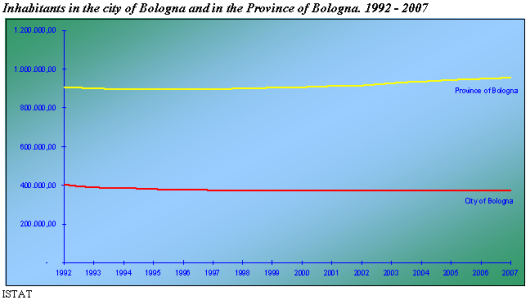About Bologna
In the Italian context, Bologna is an affluent city located in an affluent region (Emilia Romagna). The development of the city of Bologna has historically hinged upon two critical factors: 1) the entrepreneurial shift from agriculture to industry, thanks to the technical knowledge of people that have enabled this area to become one of the "industrial valleys" in Italy (namely the packaging valley from the leading packaging industry); and 2) the presence of the oldest university in Europe that has allowed Bologna to become a world-renowned city of knowledge and culture.
Bologna has been nick-named the city of wealth ("la grassa", the fat city) and the city of knowledge ("la dotta", the educated city). Other names derive from the presence of XII century towers in the center of the city ("la turrita", the city with towers) or the presence of a strong political subculture linked to left wing parties and historically to the Italian communist Party ("la rossa", the red city).
Over the last ten years, in a difficult competitive scenario for Italian economy, the Bologna economy has shown good signs of resilience (Banca d'Italia, 2007), thanks to the traditional specialization in the mechanical sector. The territory of Bologna has managed to preserve its traditional manufacturing base over the last decade, relying on the diverse and dynamic composition of its medium-to-low tech firm clusters.
The service sector has grown more rapidly than others over the last ten years, prompting speculation about the future of Bologna as a "tertiary city". However, small and medium-sized enterprises, which represent the backbone of the territory's economy, face a changing competitiveness scenario. Technological change is occurring in leading firms in key specialized clusters (e.g. packaging machinery) and calls for an increasing adaptive capability on the part of the local subcontractor's network. Whereas the leading firms' drive to technological change has led to a reorientation of regional policies towards the creation of a network of high-tech districts coordinated through the regional innovation agency, the low-tech small firms that represented an essential part of the "district's recipe" for development lag behind and face effects ranging from "skills mismatch" to complete closure. There is not a cut-and-dried solution to this scenario. Small firms' associations strive to introduce programs that can help to reduce the imbalances within the supply chain, but many of these efforts seem to clash with leading firms' goals of decreasing costs and increasing the pace of their technological change.
This, in turn, calls into question the role of university research, since even leading firms are dependent, to some extent, on external R&38;D. The current debate on local economic development at the regional level is indeed centered on the role of the University system as a vital actor for tech-based programs. The region Emilia Romagna has just launched a multi-year program aimed at creating a network of Technopoles in the region. So far this program has produces 27 centers of industrial research, 24 centers for innovation, and six parks for innovation. The whole system operates around seven key sectors: mechatronic, environment and energy, food industry, construction, life sciences, organizational innovation, and ICT (information and communications technologies).
In planning terms the recently released Emilia Romagna Regional Plan includes the objective of a regional system of excellence in which the metropolitan city of Bologna (with a provincial area of 915,000 inhabitants) is the hub of the entire system in terms of productive activities, infrastructures, research, etc..
Moreover, in 2007 the new city Structural Plan was adopted and a new phase in the urban planning of Bologna started; this new phase is aimed at characterising Bologna as a city of dialogue, a mid-size European city which is both accessible and attractive. The major projects of this new planning phase will be explored during the conference. For news on the new Structural plan please visit: http://www.comune.bologna.it/psc/
With regard to population, the City of Bologna has lost eight percent of its population from 1992 to 2007. The provincial area has gained population by five percent in the same period.

Some links on the city of Bologna:
The City of Bologna
Bologna on Wikipedia
PromoBologna
Bologna Hotels
Leisure in Bologna